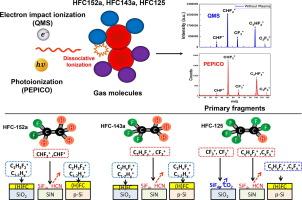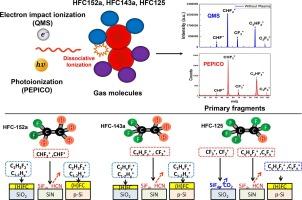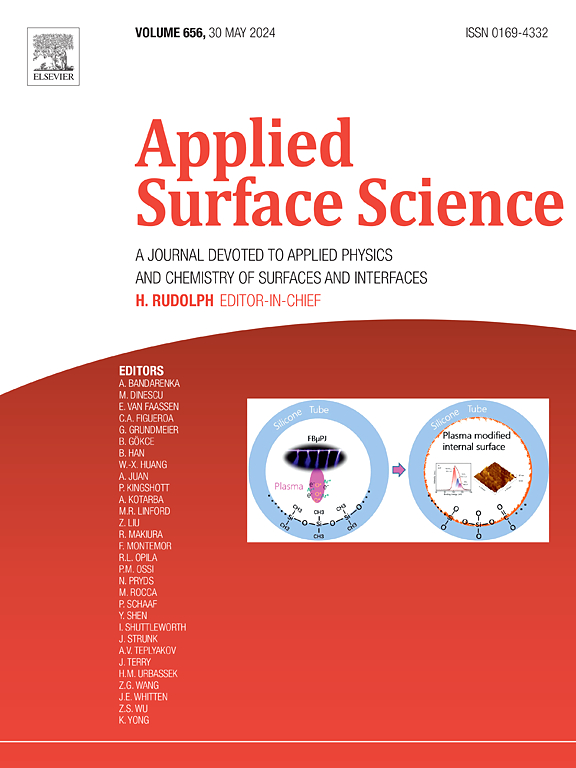Hydrofluoroethane plasma etching of SiN, SiO2, and poly-Si films with CHF2CF3, CF3CH3, and CHF2CH3
IF 6.9
2区 材料科学
Q2 CHEMISTRY, PHYSICAL
引用次数: 0
Abstract
Plasmas containing hydrofluorocarbon gases (CHF2CF3, CF3CH3, and CHF2CH3) are used for the selective removal of SiN, SiO2, and poly-Si films when manufacturing large-scale integrated circuits. Understanding the plasma chemistry of hydrofluorocarbons is important for gaining insight into the mechanisms of these selective-etching processes. The fragmental reactants produced by the reactive plasma are essential for evaluating and controlling highly accurate selective etching. This study examined such fragments using a primary dissociation ionization threshold quadrupole mass spectrometer at an electron energy of 20 eV. Their primary dissociative ionization thresholds were identified using photoelectron-photoion coincidence spectroscopy, with photon energies ranging from 10 to 28 eV. The results showed the following: (i) the CHF2CF3 molecule dissociated into ions such as CHF2+ and C2HF4+, which formed secondary ions, such as CF3+ and CF2+. The F-rich reactants effectively enhanced the etching of both SiO2 and SiN; (ii) the CF3CH3 molecule dissociated into ions such as C2H2F+ and C2H2F2+, while the dominant CF3+ remained as a crucial fragment for the primary etching of SiO2; (iii) the CHF2CH3 molecule predominantly yielded ions such as CHF2+, CF2CH3+ and CxHy+, promoting polymer film deposition on the surfaces of SiO2 and poly-Si.


用 CHF2CF3、CF3CH3 和 CHF2CH3 对 SiN、SiO2 和多晶硅薄膜进行氢氟乙烷等离子刻蚀
在制造大规模集成电路时,含有氢氟碳气体(CHF2CF3、CF3CH3 和 CHF2CH3)的等离子体被用于选择性去除 SiN、SiO2 和聚硅薄膜。了解氢氟碳化合物的等离子体化学性质对于深入了解这些选择性蚀刻过程的机理非常重要。反应等离子体产生的碎片反应物对于评估和控制高精度选择性蚀刻至关重要。本研究使用电子能量为 20 eV 的初级离解电离阈值四极杆质谱仪对这些碎片进行了检测。它们的初级离解电离阈值是通过光电子-光子巧合光谱确定的,光子能量范围为 10 至 28 eV。结果表明(i) CHF2CF3 分子离解成 CHF2+ 和 C2HF4+ 等离子,形成 CF3+ 和 CF2+ 等次级离子。富含 F 的反应物有效地增强了对 SiO2 和 SiN 的刻蚀;(ii) CF3CH3 分子离解成 C2H2F+ 和 C2H2F2+ 等离子,而占主导地位的 CF3+ 仍是对 SiO2 进行初级刻蚀的关键片段;(iii) CHF2CH3 分子主要产生 CHF2+、CF2CH3+ 和 CxHy+ 等离子,促进了聚合物薄膜在 SiO2 和多晶硅表面的沉积。
本文章由计算机程序翻译,如有差异,请以英文原文为准。
求助全文
约1分钟内获得全文
求助全文
来源期刊

Applied Surface Science
工程技术-材料科学:膜
CiteScore
12.50
自引率
7.50%
发文量
3393
审稿时长
67 days
期刊介绍:
Applied Surface Science covers topics contributing to a better understanding of surfaces, interfaces, nanostructures and their applications. The journal is concerned with scientific research on the atomic and molecular level of material properties determined with specific surface analytical techniques and/or computational methods, as well as the processing of such structures.
 求助内容:
求助内容: 应助结果提醒方式:
应助结果提醒方式:


